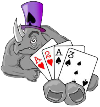 |
SLIGHT DIFFERENCE The difference is in Omaha Hi-Lo, the qualifying low hand will be the one to take half of the pot. This qualifying low hand is the one with five cards which are unique: eight or below. If there is no qualifying hand for Lo, the best Hi hand wins the whole pot. The game is played either a pot-limit or a limit fashion. |
This type of game is a drawing game. One important rule in Omaha is that you need to get out of the hand when you are not drawing to the nuts. If and when you are drawing and you see that the board pairs, a full house is more likely to happen and then you would need to get out. If more than one opponent is in the hand and you only have second or third nut low then you need to fold. It is not advisable to play second best hands, it will cost you money.
Omaha Hi/Lo uses the ‘Ace to Five’ or ‘California’ system for ranking low hands. Straights and flushes do not count against a hand, and Aces are always low, so the best possible hand is a "wheel": 5, 4, 3, 2, A. A low hand is always ranked from its highest card downwards. That's why this game is called "8 or better", or simply "Omaha 8".
Player Betting Options
In Omaha Hi/Lo are available next actions "fold", "check", "bet", "call" or ‘raise’. Exactly which options are available depends on the action taken by the previous players. Each poker player always has the option to fold, to discard their cards and give up any interest in the pot. If nobody has yet made a bet, then a player may either check or bet. If a player has bet, then subsequent players can fold, call or raise. To call is to match the amount the previous player has bet. To raise is to not only match the previous bet, but to also increase it.
After seeing his or her hole cards, each player now has the option to play his or her hand by calling or raising the big blind. The action begins to the left of the big blind, which is considered a ‘live’ bet on this round. That player has the option to fold, call or raise. For example, if the big blind was $2, it would cost $2 to call, or at least $4 to raise. Action then proceeds clockwise around the table.
When betting action is completed for the flop round, the "turn" is dealt face-up on the board. The turn is the fourth community card in an Omaha Hi/Lo game. Play begins with the active player immediately clockwise from the button.
If there is more than one remaining player when the final betting round is complete, the last person to bet or raise shows their cards. If there was no bet on the final round in which case the player immediately clockwise from the button shows their cards first. The player with the best five-card hand for high wins half the pot, and the player with the best hand for low wins the other half.
